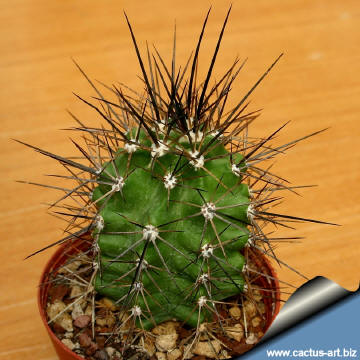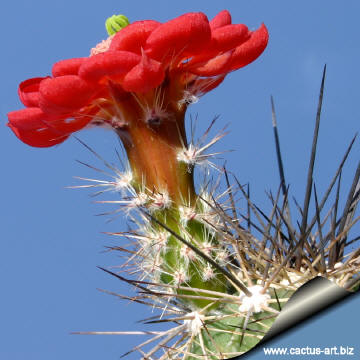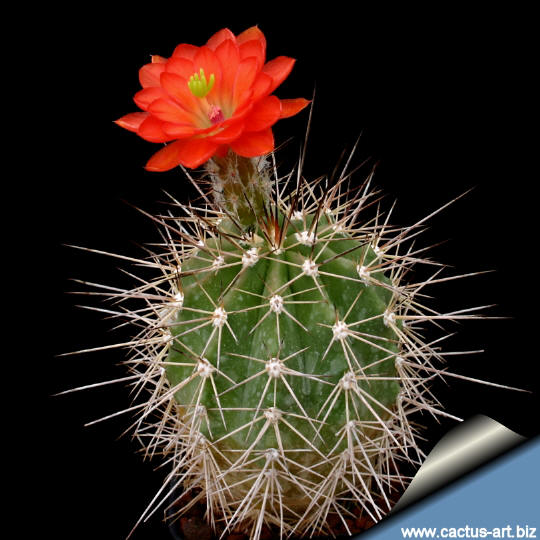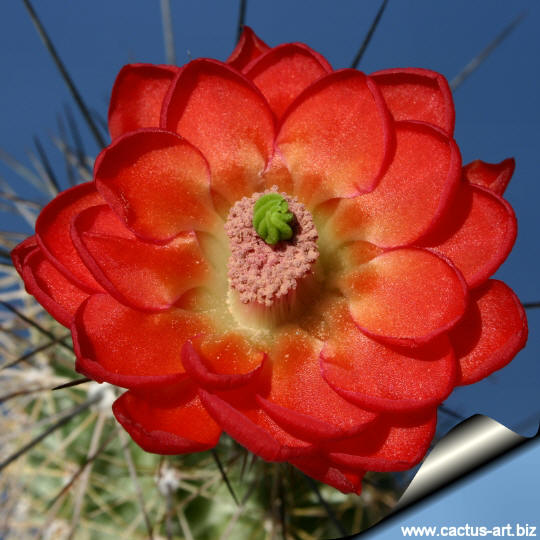|
|
|

Echinocereus polyacanthus SB191 Cusihuiriachic,
Chihuahua, Mexico,
TL
The flowers are a beautiful deep red, with many petals that form
the shape of a cup and a wooly tube.
They bloom from April through June, and are among the the first to bloom
in the desert.
|
|
Description:
Solitary or clumping, forming large clumps, generally
less than 50, but occasionally of several hundred stems.
This species
is very variable, and the several varieties are so different-looking that
the only uniting factor is the bright red bloom and rounded petals.
Stems: Light green, often tinged with red, cylindrical tapering
toward the tip, each stem up to 30 cm tall, 7 cm in diameter.
Ribs: 9 to 13, usually 10 well defined
ones, low, either tuberculate or
not.
Areoles: Approximately 1-1.5 cm apart, and somewhat woolly.
Central spines: 1 to 7, yellowish or brown, expanded basally,
straight, elongated, becoming grey as they age, reaching up to 5 cm long,
but variable in length.
Radial spines: 6 to 17 (usually about 12), dirty white or reddish,
often overlapping, up to 2 cm long but often much shorter.
Flowers: Diurnal, arising near the stem's apex, tubular to funnel-form, brilliant pinkish-orange to deep red with
a
yellowish or whitish colored throat, 3-14 cm long, 3-8 cm in diameter, ovary and tube
with yellowish spines and abundant cobwebby wool in the axil of the
scales, which is lacking in other similar species.
Blooming season: Apr-Jun, the flowers remain open for 2 or 3 days.
Blooming generally begins 5 to 10 years after sowing, as the plant
matures.
Fruit: Ovoid, green, with white pulp, indehisent and edible.
Originally this
species was incleded in
Echinocereus triglochidiatus, a name used for a large group of
diploid and polyploid taxa treated as conspecific by L. D. Benson (1969,
1982). The tetraploids are now recognized distinct species
such as
E. coccineus, including
E. polyacanthus
Engelmann of Mexico.
|
|

|
 |
|
There are a number of varieties of
this highly variable cactus species, but not all are universally
recognized. Some authorities recognize the following varieties:
E. polyacanthus ssp.
polyacanthus tends to be smaller flowered, with flowers 3-7
cm in diameter.
It occurs throughout the range of the species.
E. polyacanthus ssp. acifer has flowers 6-8
cmin diameter,
and occurs in northern, central and western Mexico.
E. polyacanthus ssp. huitcholensis has flowers
4-8 cm in
diameter. It occurs west of the Sierra Madre occidental, in western
México.
E. polyacanthus ssp. pacificus has small
flowers,
up to only three cm long.
It occurs in Baja California.
Cultivation:
This cactus is
widely cultivated for its
flowers. It
is among the easiest species to grow, flower and propagate.
Water regularly from March to October. Rot prone in winter, it needs good drainage. Claret Cups require strong sunlight to
maintain a healthy appearance, and a harsh "dry and cool" winter
environment combined with maximum light exposure enhances spring flower
production.
Frost Tolerance: Depends on the variety.
The species from Baja
California
is less resistant (hardy to -5° C);
the other varieties are
much more cold resistant (some populations can
tolerate temperatures down
to -12° C or less)
|
|
Photo of conspecific taxa,
varieties, forms and cultivars of
plants belonging to the
Echinocereus
polyacanthus
complex
(This
Taxon
has lots of synonyms whit several controversial varieties and
subspecies and comprises a multitude of different forms, but where each form
is linked to others by populations of plants with intermediate
characteristics):
Advertising
|
|
|
|
|
Family:
Cactaceae (Cactus
Family)
Scientific name:
Echinocereus
polyacanthus Engelmann 1848a:104.
TL: Mexico, Chihuahua, Cosihuiriachi, Wislizenus, 1846
(MO).
Origin: USA (South-eastern
Arizona, Western New Mexico), large areas in northwestern Mexico (Chihuaua,
Cosihuiriachi and into the Baja California Peninsula)
Conservation status: Listed in
CITES appendix 2.
Synonyms:
- Cereus polyacanthus (Engelmann)
Engelmann
1849
- Echinocereus triglochidiatus
var. polyacanthus (Engelmann) Benson 1944
- Echinocereus polyacanthus var.
acifer* Parker 1996:4 nom. nud.
= Echinocereus acifer.
= Echinocereus polyacanthus ssp. acifer
(Otto ex Salm-Dyck) Taylor 1997
- Echinocereus polyacanthus var.
acifer fa. huitcholensis Parker 1996:4. nom. nud.
= Echinocereus huitcholensis.
- Echinocereus polyacanthus var.
acifer fa. matthesianus Parker 1996:4 nom. nud.
= Echinocereus matthesianus
Common Name: Mojave Mound Cactus, Giant claret-cup cactus, Salmon
flowered hedgehog.
Etymology: Echinocerens comes
from the Greek word "Echinos" meaning "Hedgehog"
(an animal similar to a Porcupine) and "polyacanthus" is
Greek for "many spined"
|
|
|
|


A mutant with curled petals

 |
|